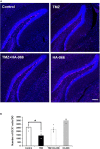Blockade of D-serine signaling and adult hippocampal neurogenesis attenuates remote contextual fear memory following multiple memory retrievals in male mice
- PMID: 36685240
- PMCID: PMC9845639
- DOI: 10.3389/fnins.2022.1030702
Blockade of D-serine signaling and adult hippocampal neurogenesis attenuates remote contextual fear memory following multiple memory retrievals in male mice
Abstract
The retrieval of fear memories induces two opposing processes, reconsolidation, and extinction. The memory reconsolidation is an active process that involves gene expression and updates an existing memory. It is hypothesized that blockade of reconsolidation by manipulating the neurobiological factors, which are mechanistically involved in the process, could weaken or disrupt the original fear memory. The N-methyl-D-aspartate (NMDA) receptor and hippocampal neurogenesis play crucial roles in hippocampus-dependent memory processes, including reconsolidation. Using contextual fear conditioning paradigm with multiple retrievals, we attempted to weaken the original contextual fear memory by repeatedly disrupting retrieval-induced reconsolidation via downregulation of NMDA receptor signaling and inhibition of neurogenesis. In the first experiment, prior to fear conditioning, NMDA receptor signaling was downregulated by the genetic reduction of its co-agonist, D-serine, and the neurogenesis was dampened by focal X-ray irradiation on the hippocampus. We found that simultaneous D-serine reduction and neurogenesis dampening resulted in a progressive decrease in freezing following each retrieval, leading to an attenuation of remote contextual fear memory on day 28. In the second experiment using the same behavioral protocols, after conditioning, pharmacological approaches were conducted to simultaneously block D-serine signaling and neurogenesis, resulting in a similar suppressive effect on the remote fear memory. The present findings provide insights for understanding the role of D-serine-mediated NMDA receptor signaling and neurogenesis in memory retrieval and the maintenance of remote fear memory, and improving the efficacy of exposure-based therapy for the treatment of post-traumatic stress disorder (PTSD).
Keywords: D-serine; hippocampal neurogenesis; multiple retrievals; reconsolidation; remote memory.
Copyright © 2023 Inoue, Ni and Mori.
Conflict of interest statement
The authors declare that the research was conducted in the absence of any commercial or financial relationships that could be construed as a potential conflict of interest.
Figures





References
-
- Balu D. T., Li Y., Puhl M. D., Benneyworth M. A., Basu A. C., Takagi S., et al. (2013). Multiple risk pathways for schizophrenia converge in serine racemase knockout mice, a mouse model of NMDA receptor hypofunction. Proc. Natl. Acad. Sci. U.S.A. 110 E2400–E2409. 10.1073/pnas.1304308110 - DOI - PMC - PubMed
LinkOut - more resources
Full Text Sources
Molecular Biology Databases

